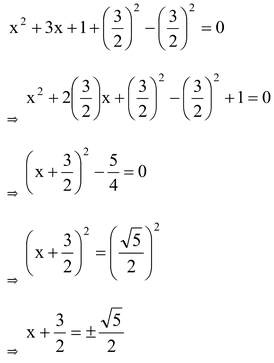Methods Of Solving Quadratic Equation
Quadratic Equations of Class 10
BY FACTORISATION:
Algorithm:

question 1. Solve the following quadratic equation by factorisation method: x2 – 2ax + a2 – b2 = 0.
Solution: Here, Factors of constant term (a2 – b2) are (a – b) and (a + b).
Also, Coefficient of the middle term = –2a = –[(a – b) + (a + b)]
∴ x2 – 2ax + a2 – b2 = 0
⇒ x2 – {(a – b) + (a + b)}x + (a – b)(a + b) = 0
⇒ x2 – (a – b) x – (a + b) x + (a – b) (a + b) = 0
⇒ x{x – (a – b)} – (a + b) {x – (a – b)} = 0
⇒ {x – (a – b)} {x – (a + b)} = 0
⇒ x – (a – b) = 0 or, x – (a + b) = 0
⇒ x = a - b or x = a + b
question 2. Solve 64x2 - 625 = 0
Solution: We have 64x2 – 625 = 0
or (8x)2 – (25)2 = 0
or (8x + 25) (8x – 25) = 0
i.e. 8x + 25 = 0 o 8x – 25 = 0.
This gives x = 25/8 or 25/8
Thus, x = - 25/8, 25/8 are solutions of the given equations.
BY THE METHOD OF COMPLETION OF SQUARE:
Algorithm:
Step-(i) Obtain the quadratic equation. Let the quadratic equation be ax2 + bx + c = 0, a ≠ 0.
Step-(ii) Make the coefficient of x2 unity, if it is not unity. i.e., obtained 
Step-(iii) Shift the constant term c/a on R.H.S. to get x2 + 
Step-(iv) Add square of half of the coefficient of x i.e.  on both sides to obtain
on both sides to obtain

Step-(v) Write L.H.S. as the perfect square of a binomial expression and simplify R.H.S. to get
 .
.
Step-(vi) Take square root of both sides to get 
Step (vii) Obtain the values of x by shifting the constant term b/2a on RHS.
question 1. Solve :- x2 + 3x + 1 = 0
Solution: We have
x2 + 3x + 1 = 0
Add and subtract (1/2 coefficient of x)2 in L.H.S. and get

This gives 
Therefore  are the solutions of the given equation.
are the solutions of the given equation.
BY USING QUADRATIC FORMULA:
Solve the quadratic equation in general form viz. ax2 + bx + c = 0.
We have, ax2 + bx + c = 0
Step (i) By comparison with general quadratic equation, find the value of a,b and c.
Step (ii) Find the discriminant of the quadratic equation.
D = b2 – 4ac
Step (iii) Now find the roots of the equation by given equation

REMARK:
If b2 - 4ac < 0 i.e. negative, then  is not real and therefore, the equation does not have any real roots.
is not real and therefore, the equation does not have any real roots.
question 1. Solve the quadratic equation x2 – 7x – 5 = 0.
Solution: Comparing the given equation with ax2 + bx + c = 0, we find that a = 1, b = –7 and c = –5.
Therefore, D = (–7)2 - 4 × 1 × (–5) = 49 + 20 = 69 > 0
Since D is positive, the equation has two roots given by 
⇒ x =  are the required solutions.
are the required solutions.
question 2. For what value of k, (4 – k)x2 + (2k + 4)x + (8k + 1) is a perfect square.
Solution: The given equation is a perfect square, if its discriminant is zero i.e. (2k + 4)2 – 4(4 - k) (8k + 1) = 0
⇒ 4(k + 2)2 – 4(4 – k) (8k + 1) = 0 ⇒ 4[4(k + 2)2 – (4 – k) (8k + 1)] = 0
⇒ [(k2 + 4k + 4) – (–8k2 + 31k + 4)] = 0 ⇒ 9k2 – 27k = 0
⇒ 9k (k – 3) = 0 ⇒ k = 0 or k = 3
Hence, the given equation is a perfect square, if k = 0 or k = 3.









